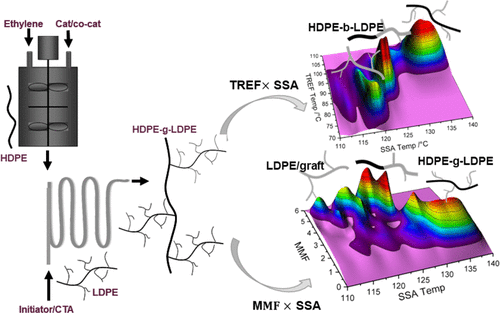当前位置:
X-MOL 学术
›
ACS Appl. Polym. Mater.
›
论文详情
Our official English website, www.x-mol.net, welcomes your
feedback! (Note: you will need to create a separate account there.)
Comprehensive Analysis of Polyethylene Graft Copolymers by Preparative Fractionation, Interaction Chromatography, and Thermal Analysis
ACS Applied Polymer Materials ( IF 4.4 ) Pub Date : 2020-11-24 , DOI: 10.1021/acsapm.0c01094 Paul S. Eselem Bungu 1 , Kristina Zentel 2 , Sascha Hintenlang 2 , Markus Busch 2 , Harald Pasch 1
ACS Applied Polymer Materials ( IF 4.4 ) Pub Date : 2020-11-24 , DOI: 10.1021/acsapm.0c01094 Paul S. Eselem Bungu 1 , Kristina Zentel 2 , Sascha Hintenlang 2 , Markus Busch 2 , Harald Pasch 1
Affiliation

|
The comprehensive analysis of complex copolymers is a challenge and requires the combination of results from different methods including size exclusion chromatography for molar mass and molecular spectroscopy for chemical composition analysis. In true copolymers, comonomers with different chemical structures are combined, resulting in various molecular compositions and topologies which can readily be identified. Different analytical challenges arise when only one monomer is used to produce complex molecular topologies. In this work, polyethylene architectures are designed by using the grafting of low density polyethylene (LDPE) onto a reactive backbone of high density linear polyethylene (HDPE). These graft copolymers consist of only ethylene repeat units. The graft copolymers are prepared by using a dual reactor setup where in the first reactor HDPE is catalytically produced. HDPE is then used as the feed for the free radical polymerization in the tube reactor. At different tube temperatures, polymers with different compositions are produced. To comprehensively analyze the molecular structure of the reaction products, they are subjected to preparative molar mass fractionation and preparative temperature rising elution fractionation. The analysis of the fractions by gradient (solvent and temperature) interaction chromatography, successive self-nucleation and annealing, and triple detection size exclusion chromatography reveals the presence of the true graft copolymer HDPE-g-LDPE along with HDPE and LDPE fractions and some HDPE-b-LDPE copolymer chains.
中文翻译:

制备级分,相互作用色谱和热分析法综合分析聚乙烯接枝共聚物
复杂共聚物的全面分析是一项挑战,需要结合不同方法的结果,这些方法包括用于摩尔质量的尺寸排阻色谱法和用于化学成分分析的分子光谱法。在真正的共聚物中,具有不同化学结构的共聚单体会结合在一起,从而产生各种分子组成和拓扑结构,这些分子组成和拓扑结构很容易确定。当仅一种单体用于产生复杂的分子拓扑结构时,就会出现不同的分析挑战。在这项工作中,通过使用低密度聚乙烯(LDPE)接枝到高密度线性聚乙烯(HDPE)的反应性骨架上来设计聚乙烯结构。这些接枝共聚物仅由乙烯重复单元组成。通过使用双反应器装置制备接枝共聚物,其中在第一反应器中催化生产HDPE。然后将HDPE用作管式反应器中自由基聚合的进料。在不同的管温度下,产生具有不同组成的聚合物。为了全面分析反应产物的分子结构,对它们进行制备摩尔质量分馏和制备温度升高的洗脱分馏。通过梯度(溶剂和温度)相互作用色谱,连续的自成核和退火以及三重检测尺寸排阻色谱对馏分进行分析,结果表明存在真正的接枝共聚物HDPE- 在不同的管温度下,产生具有不同组成的聚合物。为了全面分析反应产物的分子结构,对它们进行制备摩尔质量分馏和制备温度升高的洗脱分馏。通过梯度(溶剂和温度)相互作用色谱,连续的自成核和退火以及三重检测尺寸排阻色谱对馏分进行分析,结果表明存在真正的接枝共聚物HDPE- 在不同的管温度下,产生具有不同组成的聚合物。为了全面分析反应产物的分子结构,对它们进行制备摩尔质量分馏和制备温度升高的洗脱分馏。通过梯度(溶剂和温度)相互作用色谱,连续的自成核和退火以及三重检测尺寸排阻色谱对馏分进行分析,结果表明存在真正的接枝共聚物HDPE-g -LDPE以及HDPE和LDPE馏分以及一些HDPE- b -LDPE共聚物链。
更新日期:2020-12-11
中文翻译:

制备级分,相互作用色谱和热分析法综合分析聚乙烯接枝共聚物
复杂共聚物的全面分析是一项挑战,需要结合不同方法的结果,这些方法包括用于摩尔质量的尺寸排阻色谱法和用于化学成分分析的分子光谱法。在真正的共聚物中,具有不同化学结构的共聚单体会结合在一起,从而产生各种分子组成和拓扑结构,这些分子组成和拓扑结构很容易确定。当仅一种单体用于产生复杂的分子拓扑结构时,就会出现不同的分析挑战。在这项工作中,通过使用低密度聚乙烯(LDPE)接枝到高密度线性聚乙烯(HDPE)的反应性骨架上来设计聚乙烯结构。这些接枝共聚物仅由乙烯重复单元组成。通过使用双反应器装置制备接枝共聚物,其中在第一反应器中催化生产HDPE。然后将HDPE用作管式反应器中自由基聚合的进料。在不同的管温度下,产生具有不同组成的聚合物。为了全面分析反应产物的分子结构,对它们进行制备摩尔质量分馏和制备温度升高的洗脱分馏。通过梯度(溶剂和温度)相互作用色谱,连续的自成核和退火以及三重检测尺寸排阻色谱对馏分进行分析,结果表明存在真正的接枝共聚物HDPE- 在不同的管温度下,产生具有不同组成的聚合物。为了全面分析反应产物的分子结构,对它们进行制备摩尔质量分馏和制备温度升高的洗脱分馏。通过梯度(溶剂和温度)相互作用色谱,连续的自成核和退火以及三重检测尺寸排阻色谱对馏分进行分析,结果表明存在真正的接枝共聚物HDPE- 在不同的管温度下,产生具有不同组成的聚合物。为了全面分析反应产物的分子结构,对它们进行制备摩尔质量分馏和制备温度升高的洗脱分馏。通过梯度(溶剂和温度)相互作用色谱,连续的自成核和退火以及三重检测尺寸排阻色谱对馏分进行分析,结果表明存在真正的接枝共聚物HDPE-g -LDPE以及HDPE和LDPE馏分以及一些HDPE- b -LDPE共聚物链。











































 京公网安备 11010802027423号
京公网安备 11010802027423号